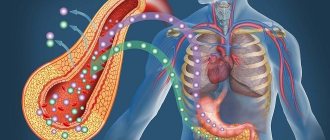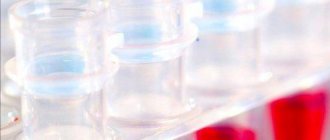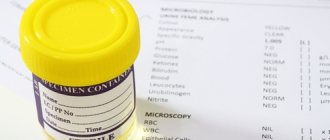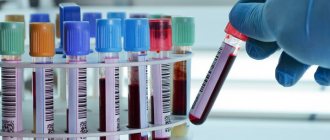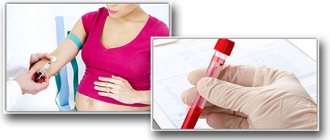Pregnancy is a period of continuous tests and examinations. One of the most important studies can confidently be called a biochemical blood test, which allows you to determine the health status of not only the mother, but also the child. It is thanks to him that the attending physician will be able to immediately see the development of certain pathologies in the pregnant woman’s body.
In this article we will talk in detail about what this biochemical analysis is, how to take it correctly, how many days it takes to do it, and how to decipher the data obtained.
What does biochemical analysis show during pregnancy?
Pregnancy is a whole bunch of changes in the female body. And it all starts from the molecular level, that is, from metabolic processes. A biochemical blood test allows you to examine and check in detail the functioning of protein, lipid and carbohydrate metabolism.
The breakdown of products occurs in the liver, therefore biochemistry refers to the so-called liver tests, the purpose of which is to characterize the state of the body not only as a whole, but also at the level of individual organs or organ systems.
Deviations from the norm
The doctor deciphers the indicators obtained during the study separately. Lack of iron in a woman’s body provokes iron deficiency anemia, which can cause large blood losses during labor. A decrease in calcium in the body of a pregnant woman is considered an abnormal situation, because the baby needs it to build muscle tissue and bones. A woman needs a special diet that compensates for the lack of this element in the body.
A decrease in potassium in the body can be caused by an overdose of medications or their side effects. If there is more potassium than needed, then this indicates a violation of cardiac activity.
Sodium is known to take an active part in the distribution of fluid in the human body. A decrease in this microelement in the blood leads to various types of neurological disorders, as well as general weakness of the body.
An increase in its concentration is observed in the early stages, when a woman suffers from toxicosis, swelling of the legs and fainting. As for phosphorus, its increase may be a symptom of kidney failure or an overdose of vitamin D, which is often prescribed to women during pregnancy.
You now know what a biochemical analysis means during pregnancy, but it is at least unwise to decipher the tests yourself during such a sensitive period in your life. If you have any differences from the norm, do not panic; modern medicine has learned to control the level of blood components very quickly and painlessly.
A woman is able to normalize some of the symptoms by eating right. Spending more time in the fresh air and normalizing physical activity. As for drug treatment, the selection of drugs will be carried out on an individual basis, depending on the problem that provoked the imbalance.
When can a doctor prescribe such a test?
A woman takes a blood test for biochemistry several times throughout her pregnancy. This is a mandatory procedure that is carried out regardless of the health status of the expectant mother.
The first time the doctor prescribes a blood test is before the pregnant woman registers with the antenatal clinic. At 18–20 weeks, you should have your blood tested again. And of course, you can’t do without blood sampling at the end of an interesting situation - at 30 weeks.
If the pregnancy is progressing well, three times to monitor the condition will be quite enough. But if there is a suspicion that a woman in labor has a serious illness, she should be checked again.
In this case, the gynecologist will check the risk of developing:
- kidney diseases;
- liver failure;
- cancerous formations;
- infectious diseases;
- systemic diseases.
Preparation rules
Preparation for taking samples.
- On an empty stomach, the contents of sugar, creatinine, bilirubin, and lipid profile are studied.
- There is a 10-hour period between eating food and taking samples. Tea, sweet coffee, fresh juice are strictly prohibited. It is possible to drink water.
- Characteristics change throughout the day, for this reason it is recommended to take tests in the morning.
- The day before the collection, it is preferable to avoid physical stress.
- Stop drinking alcohol and change your diet and daily routine.
- If possible, avoid taking medications.
It is important not to become emotionally overexcited before the study.
Preparing for the test
Before donating blood for biochemistry during pregnancy, you should adhere to certain preparation rules:
- 8 hours (or better yet 12) before the test, do not eat anything. Pregnant women are only allowed to drink water, and even then non-carbonated water.
- Taking medications should also be stopped. If this is not possible (for example, during treatment with glucocorticosteroids, when it is very important to comply with the dosage regimen), it is necessary to warn the nurse and doctor about this.
- Strenuous physical activity is prohibited.
If a pregnant woman does not comply with these rules, the research results will be distorted, and accordingly, the wrong treatment will be prescribed, and all this can easily affect the health of the child.
Norms of indicators
Protein – characterizes protein metabolism, reflecting the number of proteins in plasma.
During pregnancy, the coefficient can decrease - 44-54 g/l to 52-72 g/l. Protein increases with increased blood density and lack of water due to its rapid loss. Lipids - cholesterol - the main indicator of lipid metabolism. A physical increase from 4.25-6.3 to 5.1-7.3 mmol/l is acceptable. It is explained by an increase in the formation of magmatic sterols secreted by the liver, which are necessary for the formation of blood vessels in the child and the placenta.
Sugar is an integral part of the life process. In expectant mothers, it is permissible to reduce the level to 2.2-3.1 mmol/l due to the needs of the growing child. An increase in blood sugar is acceptable for gestational diabetes. The norm is 2.8-6.7 mmol/l.
Alanine aminotransferase – the limit is up to 51 U/l. Aspartate aminotransferase measured up to 50 U/l. A slight increase in characteristics is provoked by mild to moderate gestosis. An increase in ALT 89 IU/l and AST 148 IU/l is an indicator of a severe form of gestosis and indicates that the liver cannot cope with the load.
An increased bilirubin level of 3.3-18.2 is a sign of jaundice.
In pregnant women, a decrease in creatinine down to 36-80 µmol/l is acceptable, when the norm is 53-97 µmol/l.
The contents of elements in a blood test during pregnancy are considered significant:
- a decrease in iron in pregnant women above 8.84 - 23.7 µmol/l is a hidden sign of iron deficiency anemia, typical for mothers;
- a rather high sodium level above 126-135 mmol/l is likely in the presence of toxicosis;
- a decrease in potassium levels 4.1-8.3 - determines renal failure and drug overdose;
- calcium deficiency 3.20 - 3.55 - typical during pregnancy, which can be explained by the child’s need for bone formation
- An increase in phosphorus content in the blood of more than 1.0-1.4 mmol/l indicates an overdose of vitamin D and renal pathology.
Biochemistry during pregnancy is performed twice: upon registration and at 29 weeks. Blood is taken from a vein on an empty stomach in the morning.
How to take a biochemical blood test
Blood is drawn from the ulnar vein.
The process of donating blood for biochemistry includes following the following rules:
- Blood can be donated only in the morning and on an empty stomach.
- You need to watch how tightly the tourniquet is tightened on your hand. If it lies too tightly, the protein level, for example, increases. This may lead the attending physician to form false conclusions.
- You should not make sudden movements, as this will lead to fluctuations in the level of analyzed substances in the blood.
If the results of the analysis showed slight deviations from the norm, in no case should you think that you can no longer go to the doctor, because everything is fine. Minimal deviations may be the first sign of a serious or even incurable disease. Therefore, you should familiarize your doctor with the results of any studies, including biochemical blood tests.
results
What does a biochemical blood test show in pregnant women? Why is it needed, is it really necessary? This blood test is mandatory for pregnant women to assess the state of her health. Then all deviations from the norm can be detected in time, and if necessary, the doctor will prescribe treatment for the woman after the examination, as long as there is no threat to the child’s health. How are the results of the analysis evaluated? We will not talk about this in detail, briefly, you can learn more about them later from your doctor, but in a few words we will tell you what they usually pay attention to when assessing a biochemical blood test in a pregnant woman. This table will help you find out what's what.
We will briefly describe how to evaluate the results obtained.
- Protein. How much protein should a healthy woman have? The protein norm is from 63 to 83 g/l. But this is before the 3rd trimester. After some time, its amount may decrease to 55 - 65 g/l. If the indicators are different, then something is wrong in the body. But it could also be due to dehydration. This test should not be confused with a urine test. Elevated protein in it may indicate that the expectant mother has gestosis. This is a dangerous disease that has other symptoms.
- Cholesterol. Biochemistry shows how much cholesterol is in the blood. How do you know how much it should be? The norm is from 1.15 to 5.8 mmol/l. But is it acceptable to raise cholesterol? But in pregnant women it can be up to 6.2, but the numbers above indicate that she is developing atherosclerosis.
- Glucose. A vital component is glucose. What quantity, how much should it be? During pregnancy, it is allowed if there is from 3.5 to 5 mmol/l glucose in the blood.
- Insulin. This is a hormone produced by the pancreas. Is it important? Yes. If there is very little insulin, women may develop gestational diabetes during pregnancy. If the analysis shows a reduced amount of insulin, then during the second trimester an additional test is performed to determine the amount of glucose in the blood.
- Enzymes. What else is important to check during pregnancy? Amount of enzymes required. Is it really that important? If the tests are bad, this may indicate the presence of some disease. What quantity, how many enzymes should there be? So, the level of aspartate aminotransferase should not exceed 32 U/l; if it exceeds the norm, this indicates that the woman has gestosis.
What does increased or decreased protein tell you?
A person is an organism of protein origin from a biological point of view, therefore the most important and most important indicator of a biochemical blood test will be the level of total protein.
Normally, in healthy adults, the protein concentration in the blood is 65–85 g/l. During pregnancy, this figure drops to 55–65 g/l - for pregnant women these are the numbers that are considered the norm. This is due to an increase in the volume of a pregnant woman’s blood plasma, but a decrease in red blood cells - erythrocytes. Particularly low protein levels are observed in the third trimester and even during lactation, that is, breastfeeding.
In addition to the value of total protein, the results of biochemical analysis also indicate the concentration of albumin and globulins separately.
About 60% of the total protein is albumin. The role of this protein substance in the body is to transport nutrients to their destination (to a specific organ). As the number of red blood cells decreases during pregnancy, albumin also decreases.
In the 1st trimester, the albumin norm is 32–50 grams per liter; in the 2nd trimester – 28–56 g/l; in 3 – 26–66 g/l.
Globulins are a component of proteins that take part in inflammatory processes. Normally, there should not be a lot of globulins in the body (28–112 g/l). An abundant amount of globulins in the blood of a pregnant woman indicates hyperproteinemia.
However, it also happens that the level of protein in the body is significantly reduced compared to normal levels. In what cases does this happen?
Reduced protein indicates the appearance or presence of diseases such as:
- liver failure, which prevents the organ from optimally absorbing proteins;
- cancer;
- hyperthyroidism (in other words: thyrotoxicosis) is a condition in which the thyroid gland produces too much thyroid-stimulating hormones;
- hereditary diseases (for example, hepatocerebral dystrophy, which is characterized by impaired absorption of copper (Cuprum), as a result of which the central nervous system is affected);
- renal failure;
- internal bleeding;
- excess water, which leads to the development of ascites, abdominal dropsy (accumulation of fluid in the abdominal cavity) and hydremia (increased amount of water in the blood, which leads to a decrease in the number of red blood cells);
- acute poisoning;
- malabsorption (impaired absorption of nutrients by the small intestine);
- an inflammatory process in the digestive canal, which impairs the absorption of proteins.
It’s even worse if pregnant women have elevated protein levels.
This may indicate the presence of:
- infectious diseases;
- oncological formations that are characterized by hyperproduction of protein - for example: myeloma (this is a tumor of plasma cells), lymphogranulomatosis (in other words: Hodgkin's disease) - this is a tumor of lymphoid tissue;
- autoimmune diseases, which are associated with disruption of the functioning of the human immune system, when T-lymphocytes (immune cells) begin to fight their own tissues, perceiving them as foreign;
- dehydration, which occurs due to frequent diarrhea or vomiting.
A condition in which the level of protein in the body is reduced is called hypoproteinemia (protein is protein); and a disease characterized by an increased concentration of protein in the blood is called hyperproteinemia.
In any case, deciphering a biochemical blood test should be done exclusively by a doctor. He will decide whether deviations from the norm are considered an indicator of illness or simply a symptom of pregnancy.
Lipid metabolism during pregnancy
Biochemical analysis necessarily determines the fat content. Most often, only cholesterol is checked. In some cases, triglyceride concentrations are also studied. Cholesterol is one of the most important indicators of lipid metabolism. This element is needed to build the normal structure of the body’s cell membranes. It takes part in the production of vitamin D, sex hormones and a number of other acids and elements.
With age, cholesterol concentrations change. For young women, the norm is 3.15-5.8 mmol/l. During pregnancy, in particular in the 2nd and 3rd trimesters, the content of total cholesterol increases to 6.0 mmol/l and slightly higher. This change is due to the fact that the liver begins to produce fats in larger quantities. They are spent on building the vascular bed of the fetus and placenta.
During pregnancy, an increase in cholesterol levels is observed primarily due to low-density lipoproteins. The content of high-density lipoproteins remains almost unchanged. Normally, high-density lipoproteins are contained in the blood at a level of 0.9-1.9 mmol/l. Their concentration does not depend on age. During pregnancy, under normal circumstances, it also does not change. Patients with excess weight and diabetes mellitus must donate blood for a comprehensive check of lipoprotein composition.
As for triglycerides, these fats act as the main source of energy for the cells of the human body. These elements enter the body directly with food. Additionally, they are produced by intestinal cells, adipose tissue and liver. Normally, triglyceride levels in young patients should not go beyond 0.4-1.7 mmol/l. The norm itself depends on the girl’s age. During pregnancy, there is an increase in the concentration of female sex hormones. Protein content decreases. The combination of these two factors leads to an increase in triglyceride levels, which is noted in the 2nd and 3rd trimesters. If the indicator does not exceed 2.7 mmol/l, then there is no need to worry unless the doctor says otherwise.
Why is it important to know your glucose level?
The state of carbohydrate metabolism can be checked by finding out the concentration of glucose in the blood. Normally for pregnant women it should be 3.5–6.5 mmol/l. After sleep or after a long fast, the sugar level drops, after eating it increases.
Glucose levels can be checked not only by drawing blood from a vein, but also using a glucometer. And since it is very important for a pregnant woman to monitor the concentration of this particular substance, you can check it yourself at any time.
So why exactly is information about the concentration of glucose in the blood of the expectant mother so necessary for doctors?
Pregnant women have a huge risk of developing diabetes. After childbirth, it may disappear, or it may degenerate into permanent type 2 diabetes. In women with gestational diabetes (that is, diabetes during pregnancy), the risk of developing type II diabetes increases by 2–4 times!
For more information about gestational diabetes, its symptoms and treatment, watch this video:
Cholesterol level in biochemical analysis
A variety of factors lead to increased blood cholesterol. Among them:
- Genetic diseases transmitted by inheritance.
- Various diseases of the pancreas and liver.
- Decreased thyroid function.
- Eating fatty foods in excessive quantities.
- Diabetes.
- Kidney problems.
A decrease in cholesterol levels is observed with:
- Prolonged fasting.
- Severe toxicosis during the first half of pregnancy.
- Increased thyroid function.
- Various kinds of infectious diseases.
The content of high-density lipoproteins increases in patients with:
- Diabetes mellitus.
- Overweight.
- Increased thyroid function.
A decrease in their concentration leads to:
- Diabetes.
- Smoking.
- Diet with a lot of carbohydrates.
- Kidney diseases.
Low-density lipoproteins increase in the presence of thyroid and kidney diseases, as well as in diabetes mellitus. Their reduction is caused by:
- Diseases of the joints and lungs.
- Chronic anemia.
- Increased thyroid function.
They also decrease with a diet low in animal fats, stress, and decreased thyroid function.
An increase in triglycerides is observed in a number of hereditary diseases, diabetes mellitus, diseases of the pancreas and kidneys, and inflammatory diseases of the liver. Triglycerides decrease against the background of:
- Chronic lung diseases.
- Excessive thyroid function.
- Insufficient and/or unhealthy nutrition.
Norm of bilirubin
Bilirubin is a bile pigment that comes in two types:
- direct (connected with molecules of transported substances);
- indirect (free from molecules of other products).
If tests show that there is no direct bilirubin at all, this will be a good sign. But the indirect norm is approximately 3.5–25.0 mmol/l. Slight fluctuations in the level of bilirubin in the blood are possible. Typically, pregnant women do not have problems associated with increased or decreased levels of bilirubin.
A slight increase does not indicate pathology, but a significant increase indicates development:
- hemolytic anemia;
- cholecystitis;
- viral hepatitis.
All of these diseases are very serious: they not only negatively affect the health of the mother, but can also lead to premature birth or stillbirth.
However, most often, when bilirubin in the blood increases, a pregnant woman develops jaundice. This is due to stagnation of bile. With a slight increase in bilirubin concentration, it can be quickly reduced by a sharp change in air temperature. Why this happens is unknown, but it can be used well.
The level of pigment in the mother’s blood can also be underestimated. And although this phenomenon is not common, it still needs to be considered. Previously, this was considered a normal option, but now, after research, experts have proven that a low level of bilirubin in the mother’s blood indicates the development of coronary heart disease.
For a more detailed analysis of the condition of the gallbladder, ultrasound screening should be performed.
Analysis of metabolic processes
Protein performs a number of functions necessary to maintain the patient’s condition during pregnancy. The component has a beneficial effect on the body's protective functions and blood quality. A sufficient amount of protein gives it the necessary coagulability, viscosity and fluidity. The analysis most often involves an assessment of total protein. Normally, its indicators range from 64-83 g/l.
The total protein consists of elements of different structures and functions, called protein fractions, consisting of albumins, alpha, beta and gamma globulins. By analyzing the ratio of these components, the doctor assesses the degree of disruption of the internal organs. A slight decrease in performance is not a pathology. A decrease in the amount of total protein in the blood to 55-64 g/l is considered normal. This factor most often appears after the 3rd trimester of pregnancy and is due to the following reasons:
- an increase in the amount of plasma, which leads to blood thinning;
- intensive consumption of albumin for the formation of fetal tissue;
- dysfunction of the liver, kidneys, pancreas;
- insufficient consumption of protein foods.
Exceeding normal values is a sign of dehydration of the patient’s body, the presence of chronic diseases or acute infections.
Lipid metabolism during pregnancy is most often characterized by the level of cholesterol in the blood, which is the main element of cell membranes, a factor in the production of bile and vitamin D. In the 1st trimester of pregnancy, its normal levels range between 3.15 and 5.8 mmol/l. In subsequent periods they can reach 6.2 mmol/l. Exceeding the optimal values may be associated with a genetic predisposition to excess cholesterol, pathologies of the liver, kidneys, diabetes mellitus, and abuse of fatty foods. A decrease in the permissible norm indicates insufficient nutrition, excessive thyroid function, and the presence of infections.
Carbohydrates are the main factor in energy support for the body. A disruption in the metabolism of these elements can lead to general weakness, tremors of the limbs, confusion, anxiety, a sharp feeling of hunger, etc. A blood test is required to determine the amount of glucose. The optimal value of this component is from 4 to 6 mmol/l. Exceeding the permissible values indicates a violation of carbohydrate metabolism caused by insufficient secretion of insulin due to a manifold increase in the need for its production.
Changes in enzyme content
The most important enzymes in pregnant women are ALT (alanine aminotransferase), AST (aspartate aminotransferase) and GGT (gamma-glutamyl transpeptidase). It is their concentration that is determined during a blood test for biochemistry.
The normal level of both alanine and aspartate aminotransferase in a pregnant woman should be 30 - 32 units/ml.
ALT is found mainly in liver cells. AST can be found in almost all human organs (heart, liver, pancreas, lungs, etc.).
You need to be wary when enzyme levels increase. This may indicate the development of kidney, liver or heart disease. In pregnant women in the 3rd trimester, the level of ALT and AST almost always increases due to severe toxicosis.
Biochemical analysis of blood composition during pregnancy: permissible norm of nitrogenous substances
The result of the study and decoding of the levels of nitrogenous substances are important for the health of the pregnant woman. These substances include uric acid, urea and creatinine. These substances are produced during protein metabolism and are indicators that allow us to reliably determine the quality of kidney function and notice failures due to certain pathologies.
Urea, which normally should be between 2.5 and not more than 8.4 mmol/l in a woman during pregnancy, is the end result of protein breakdown. There is a slight decrease in the norm of this element; its content may change later in the pregnancy due to an increase in blood volume and changes in the woman’s circulatory pattern.
This product is excreted through the kidneys and urinary tract. An increase in urea levels directly indicates a malfunction of these organs. A diet with a predominance of protein products can increase the concentration of this substance above the maximum norm. Poisoning, lack of food, and liver dysfunction reduce it.
Creatinine is formed mainly in human muscle tissue; it is also a metabolic product. If its value is increased (when the result of the analysis shows a result higher than 97 in the early stages or more than 70 units in the second and third trimester of pregnancy).
If a woman is susceptible to dehydration, has problems with her kidneys, has increased production of thyroid hormones, or has significant muscle damage, creatinine is produced in excess. This nitrogenous substance increases if the patient loves meat and eats it in large quantities.
How to normalize the results of biochemical analysis in pregnant women - the doctor advises
As experience and research show, health problems in pregnant women begin due to an increase in blood volume and a decrease in the number of red blood cells in it.
To normalize the results of biochemical analysis, you should follow these recommendations.
Consume foods rich in iron to restore hemoglobin levels in the blood:
- “vitamin bomb”: mix walnuts, dried apricots, dates, raisins and figs, crush, add lemon juice and honey - take one tablespoon twice a day;
- meat products: liver, veal, beef;
- fruits: pomegranates, apples, oranges;
- dried fruits: walnuts, dried apricots;
- cereals: buckwheat, oatmeal;
- legumes: beans, peas, soybeans;
- seaweed;
- quail eggs.
Twice a day, morning and evening, before meals, steam and take decoctions and infusions of a mixture of medicinal herbs:
- chamomile;
- dog nettle;
- mint;
- St. John's wort.
Doctors recommend periodically cleansing the intestines by taking activated charcoal. And also avoid stressful situations in every possible way.
Doctors do not recommend taking synthetic drugs.
Preparing and conducting analysis
Like any analysis, blood biochemistry has its own indications for carrying out; they, as a rule, relate to diagnosing a woman’s condition during pregnancy, monitoring the effect of drug therapy that is used, as well as to determine possible hidden diseases that occur. The procedure is carried out very quickly, you won’t have to wait long for test results, they are usually ready on the second day. Venous blood is required for diagnosis.
The procedure itself is no different from collecting material from healthy people. The only difference is that pregnant women are more susceptible, so there is a possibility of fainting during the removal of biomaterial. To prevent this, the doctor prepares ammonia in advance. It will help bring the patient to consciousness, and during blood removal, the doctor recommends that the woman turn in the other direction and not look at the blood.
The procedure is practically painless, but for some it may cause an unpleasant sensation that lasts for several moments. The doctor places a tourniquet on the patient’s arm, smears the skin with a cotton swab and anesthetic, then pierces it with a needle and withdraws the blood into a test tube. Next, the test tube is sent to the laboratory and examined as soon as possible.
To ensure that the test results are as reliable and accurate as possible, it is recommended that you carefully prepare for the study. Preparing for the test involves avoiding fatty, canned and fried foods on the eve of the test. The last meal should be consumed no earlier than 8 hours before the test, which is why the most optimal time for testing is the morning. Before the procedure itself, you should not drink juices, teas or coffee, and eating is also prohibited. Only minor consumption of plain still water is allowed.
Before undergoing the procedure, it is also necessary to give up all kinds of vitamins that are taken in tablet form, and medications that were prescribed by the doctor. If you have chronic diseases that cannot be avoided, consult your doctor. He will individually decide which drugs to leave and which ones may affect the decoding of the analysis and distort the results.
Taking into account the fact that different laboratories use different equipment, sometimes the normal indicators may differ from each other; patients should take this into account and not try to diagnose themselves. Only a qualified specialist can accurately analyze the indicators and make a diagnosis.
During pregnancy, a woman may be prescribed this test several times; it does not negatively affect the woman’s condition, so there is no need to worry about the fact that more blood may be taken from her than necessary. For a full diagnosis, doctors usually need 5 ml of blood.
Aspartate aminotransaminase enzyme
If you are not feeling well, you should contact your doctor.
This enzyme is similar to ALT. It is also responsible for the breakdown of amino acids by tissue cells. The main amount of AST is contained in the heart muscle - the myocardium. There is also a small amount of the substance in the liver tissues and kidneys.
The growth of this enzyme also has pathological and non-pathological reasons. If the norm is significantly exceeded, the cause is a malfunction of the heart muscle. This disease is fraught with the development of heart disease. If a sharp increase in the enzyme is detected, additional consultation with a cardiologist is necessary. Only according to the results of ultrasound diagnosis can a violation of the heart function be excluded.
In rare cases, AST increases due to chronic liver or kidney disease. It is for this reason that AST and ALT levels should be closely monitored. The normal level of aspartate aminotransaminase enzyme is 30 U/ml.
Doctors also note that exceeding the norms of AST and ALT in the first half of pregnancy is not a sign of pathology. The negative change occurs due to increased load on the liver. At the same time, the heart is also forced to pump out a larger volume of blood. By the end of the second trimester of pregnancy, these enzymes return to normal.
When is it appointed?
The analysis is not considered integral, but is prescribed if the expectant mother has chronic diseases:
Depending on the signs and severity of the pathology, the range of parameters studied can increase.
In addition, biochemical study makes it possible to establish the degree of glucose.
The analysis may be needed for women who are obese or overweight, that is, those who are at risk of developing gestational diabetes.
Alanine transaminase compound
This compound is an enzymatic component of the cell. Large amounts of the enzyme are found in the cells of the liver, heart and lungs. The rate of the enzyme compound should not exceed 30 U/ml.
Biochemical analysis may show a significant excess of the norm. This increase is observed in severe forms of various liver diseases. Growth is detected in patients with pancreatitis, hepatitis of various forms, and hepatic lesions. In these diseases, liver cells die. The enzyme, fixed in the cyst shell, is released into the circulatory system. In this case, the expectant mother needs urgent hospitalization. Without proper medical control, the life of a woman and child is in danger.
But ALT does not always indicate the development of serious illnesses. A slight increase in the enzyme is characteristic of the first trimester of pregnancy. Gradually the liver gets used to the increased load. ALT levels return to normal.
How and when is blood biochemistry performed?
The first time a woman undergoes a biochemical blood test is when she registers at the hospital. Then the procedure is repeated at 30 weeks of pregnancy, but if necessary, biochemistry can be prescribed earlier.
At least 12 hours must pass before the test and the last meal. In order for the result to be as accurate as possible, in addition to food, doctors also recommend refraining from drinks (even water) and chewing gum before collecting blood. The procedure is generally performed in the morning, and blood is taken from the cubital vein.
What it is?
A laboratory diagnostic method such as a biochemical blood test is very common in medicine. And this is not without reason - the results of the study make it possible to get the most complete picture of the state of health of the expectant mother, of the slightest changes in the functioning of her internal organs.
During pregnancy, a large load falls on the heart, liver, kidneys, and endocrine system. Monitoring their activities is an important component of dispensary records.
In addition, the results of the analysis allow us to judge how metabolic processes proceed - carbohydrate and salt metabolism, and whether the woman has enough important vitamins and minerals. They are needed not only for her, but also for the normal growth and development of the baby, since he receives everything he needs for this from the mother’s blood.
In the blood of a pregnant woman, biochemistry is used to determine the concentration of sugar and urea, creatinine and total protein, cholesterol and many different proteins and lipids, changes in which in relation to normal values may indicate a developing pathology of internal organs, inflammation or an allergic reaction.
The analysis is not mandatory ; it is only recommended by the Russian Ministry of Health for examining pregnant women. Every woman theoretically has the right to refuse such a diagnosis. But this should not be done, since violations identified in time allow doctors to quickly respond and begin treatment, saving the lives and health of both the woman and her baby.
It took medicine and science several decades to figure out the chemical and biological components of all the processes occurring inside the expectant mother, as well as to find out what is considered normal for pregnant women and what is pathological.
Biochemical blood analysis in pregnant women is a different story, since the indicators in their blood differ significantly from the indicators in the blood of non-pregnant women and men.
Normal and pathological: how to determine boundaries during pregnancy
Blood biochemistry standards for pregnant women differ from normal values for a non-pregnant body. This is another fact in favor of the fact that the doctor should decipher the analysis.
But below we will consider what each specific indicator says and present one of the tables of normal biochemical indicators.
Table 1. Biochemical blood test: norm by trimester of pregnancy
| Biochemical indicator | Units | Normal in 1st trimester | Normal in 2nd trimester | Normal in the 3rd trimester |
| Total protein | g/l | 63-83 g/l | ||
| Albumen | g/l | 32-50 | 28-55,7 | 25,6-66,0 |
| Urea | mmol/liter | 2,5-7,1 | 2,5-7,1 | 2,5-6,2 |
| Cholesterol (cholesterol) | mmol/liter | 6,16-13,7 | ||
| Globulin | g/l | 28-112 | ||
| Sugar (glucose) | mmol/liter | 3,5 – 5,83 | ||
| Creatinine | 32-70 | 32-50 | 32-47 | |
| Diastasis | units/l | 25-125 | ||
| ALT | units/l | Up to 32 | Up to 31 | |
| AST | units/l | Up to 31 | Up to 30 | |
| GGT | units/l | Up to 36 | ||
| Total bilirubin | µmol/liter | 3,4 -21,6 | ||
| Direct bilirubin | µmol/liter | Up to 7.9 | ||
| Indirect bilirubin | µmol/liter | 3,4-13,7 | ||
| Alkaline phosphatase | units | 40-150 | 40-190 | 40-240 |
| Iron | 8,93-30,4 | 8,93-30,4 | 7,2-25,9 | |
| Sodium | mmol/liter | 135-155 | 135-145 | 135-155 |
| Chlorine | mmol/liter | |||
| Potassium | mmol/liter | 3,4-5,3 | 3,4-5,5 | 3,4-5,3 |
| Phosphorus | mmol/liter | 1,0-1,57 | 1,0-1,40 | 0,87-1,47 |
| Magnesium | mmol/liter | 0,85-2 | 0,85-1,7 | 0,85-1,4 |
Decoding protein metabolism indicators
Total protein is one of the parameters that is necessarily present in the analysis of blood biochemistry.
Albumin is determined less frequently, mainly when total protein is reduced. During pregnancy, it is determined if a woman has edema syndrome or gestosis in the 3rd trimester. In case of pregnancy complications, total protein does not reflect the situation, and albumin is a more sensitive parameter.
From the 8th week of pregnancy, the protein decreases, after the 20th week it reaches the lower limit of normal and continues to “fall”. For pregnant women, it is normal to reduce the amount of protein by 10% below the lower limit of normal. The decrease occurs not due to the fact that the body synthesizes it poorly or does not get it enough from food, but due to an increase in consumption:
- the volume of circulating blood increases, as a result of which there is more liquid part of the blood, and fewer dissolved substances and cells;
- energy costs are growing;
- more plastic material is needed to build fetal cells.
Protein fractions are rarely looked at: if the protein concentration exceeds the upper limit of normal. During pregnancy, protein fractions change, but their changes are not indicative of diagnosis.
If a pregnant woman has kidney problems, severe edema, or signs of preeclampsia, then albumin will be greatly reduced.
Nitrogen metabolism indicators
Protein supplied with food is transformed into smaller fractions - amino acids. The liver synthesizes protein, which is used for the body's needs. In parallel, three substances are formed that characterize protein metabolism:
Classically, during pregnancy, creatinine and urea are determined in a biochemical blood test.
Uric acid is determined when there is suspicion of:
- gout;
- a woman actively follows a protein diet during pregnancy;
- late toxicosis.
During pregnancy, an increase in uric acid levels becomes a marker of pregnancy complications and makes it possible to make predictions regarding them.
Urea during gestation remains virtually unchanged or decreases to the lower limit of normal.
Creatinine may be significantly lower than normal. This is due to the fact that the kidneys actively remove metabolic products. An increase in the glomerular filtration rate helps the pregnant woman’s body quickly rid itself of metabolic products that are toxic to the baby, and along with them, creatinine (to a greater extent) and urea (to a lesser extent) are “lost.”
Biochemical markers of carbohydrate metabolism in the blood
The norms for this group of indicators during pregnancy change greatly. Carbohydrate metabolism markers include:
- blood plasma glucose;
- oral glucose tolerance test.
The level of glucose in your blood plasma will be different from the glucose concentration taken during a regular blood sugar test.
During pregnancy, the upper limit of normal for glucose is 5.1 mmol/l (for an ordinary person -5.5). If a pregnant woman’s sugar level is 5.1, then this is a reason to consult an endocrinologist.
The glucose concentration in the morning on an empty stomach may be normal, therefore, if signs of gestational diabetes mellitus appear in pregnant women, an additional test is prescribed - a glucose tolerance test (GTT). Throughout the night, the fetus actively consumes glucose to meet its needs, so the blood sugar level in the morning on an empty stomach does not reflect the true situation. To identify hidden disorders of carbohydrate metabolism, GTT is prescribed. The essence of the analysis is to determine the glucose level after exercise. The determination of “sugar” is carried out on an empty stomach, then 1 hour after taking 75 g of glucose and after 2 hours.
Deciphering biochemical indicators of lipid metabolism
During pregnancy, biochemical blood tests are often limited to cholesterol. Less commonly studied is the lipid spectrum, which includes, in addition to total cholesterol:
- triglycerides;
- high, low and very low density lipoproteins.
Total cholesterol during pregnancy can increase significantly - up to 6-8 mmol/l. The thing is that if the baby does not have enough glucose (for example, the mother is sleeping or skipped lunch), the biochemical processes in the pregnant body quickly “switch” to the breakdown of fat reserves. If you take a general urine test at this time, ketone bodies (acetone) will appear in it. Increased cholesterol and acetone in the urine indicate that active processes of lipolysis, the oxidation of fatty acids, occurred at night.
To normalize metabolism at night, it is recommended to have a snack immediately before bed (so that the baby has enough glucose until the morning). This could be an apple, a small sandwich, a glass of kefir or milk of your choice.
Enzymes
In the direction of “blood biochemistry” during pregnancy, transaminase enzymes may be indicated:
- alanine aminotransferase (ALT or ALT);
- aspartate aminotransferase (AST or AST).
Basically, they reflect the quality of liver function. These enzymes are found in liver cells. If hepatocytes - liver cells - are destroyed, the level of enzymes in the blood increases. But their level during pregnancy can be increased for other reasons:
In severe toxicosis, the ALT level reaches up to 300 U/L. With this result, the doctor will prescribe additional tests and instrumental methods for examining the liver, but this figure is not critical. For comparison: with viral hepatitis, ALT increases to 3000-4000.
ALT and AST during pregnancy can increase with hepatic cholestasis (stagnation of bile in the hepatic ducts) due to increased compression by the large uterus. Together with them, the concentration of bilirubin, alkaline phosphatase, and lactate dehydrogenase will increase. Cholestasis during pregnancy is more typical in the 3rd trimester.
Symptoms that suggest cholestasis in a pregnant woman:
- skin itching;
- dry skin;
- change in skin and urine color.
If these signs appear, it is important to consult a doctor promptly. In addition to discomfort for the mother, there is a danger for the baby. High bilirubin is toxic to the fetus, especially to brain tissue. In critical situations, a decision may be made about early delivery.
Another reason for increasing the concentration of liver enzymes in the blood plasma is excessive drug load. It can be observed when medications are prescribed in combination with “maintenance” therapy (for example, taking vitamins). First of all, it is necessary to discontinue medications prescribed for non-therapeutic purposes. Then evaluate whether the body responded by reducing transaminases. That is, the prescription of hepatoprotectors and bile-thinning drugs may not be necessary.
Sometimes it is enough to simply stop unnecessary medications to normalize ALT and AST.
Recommendation! Beware of taking multivitamin complexes during pregnancy, especially long-term courses.
ALT and AST increase with late gestosis (late toxicosis). This is a serious complication of pregnancy; every obstetrician-gynecologist is wary of it. If liver enzymes are elevated in the biochemical blood test for this reason, then the decision about an earlier delivery is also weighed.
Bilirubin may increase slightly during pregnancy. When the bilirubin level is 30-35 mmol per liter, you can notice yellowness of the whites of the eyes and mucous membranes.
High bilirubin – 60 mmol/l requires close biochemical monitoring of the blood.
Exceeding the norm is associated with Gilbert's syndrome, which is characterized by the destruction of red blood cells. The breakdown of red blood cells releases bilirubin.
A slight increase of a few units from the norm is not dangerous for either the baby or the mother.
Alkaline phosphatase is an enzyme that is very often elevated during pregnancy. This is due to the fact that the enzyme is present not only in the liver. Alkaline phosphatase (ALP) is produced in the cells of the gastrointestinal tract, bones, and placenta. During pregnancy, the entire enzyme pool consists largely of the placental fraction. Therefore, an increase in phosphatase concentration during pregnancy occurs against the background of:
- placental insufficiency;
- physiological processes in the placenta. But an increase above the upper limit of normal is associated with disorders in other organs.
Also, alkaline phosphatase in pregnant women can be a marker of bile stasis, along with skin itching and yellowing of the sclera.
Lactate dehydrogenase (LDH) increases for the same reasons as alkaline phosphatase. Exceeding normal numbers is observed with edematous syndrome and preeclampsia. Eclampsia is characterized by the destruction of red blood cells - hemolysis. In this case, the LDH level increases and will be a marker not of cholestasis, but of hemolysis. The more the norm is exceeded, the more unfavorable the prognosis for eclampsia.
Macro and microelements in biochemical blood analysis in pregnant women
The serum level of micro- and macroelements does not reflect their supply in the maternal body. A biochemical blood test allows you to assess the levels of:
In pregnant women, the supply of microelements is stored not in the liquid part of the blood, but in the hair and nails.
Private laboratories offer the determination of minerals and trace elements not only in plasma, but in hair (MAV diagnostics). The cost is quite high, for example, determining 12 elements in hair costs from 50 euros. But according to the opinion of obstetricians and gynecologists who “save” patients’ budgets, it is not worth doing it to everyone. If you need to assess the mineral metabolism in a pregnant body to identify any diseases or pathologies of pregnancy, it is enough to take a “biochemistry” test for the main indicators.
So, in case of kidney pathology, the concentration of potassium, sodium, and chlorine is monitored. In rare situations, calcium and phosphorus levels are monitored for problems with the skeletal system.
The fetus makes its main supply of calcium not during lactation with milk, but during intrauterine development. Therefore, pregnant women need to choose the right diet, which must include dairy products. When plasma calcium levels are low, calcium tablets are prescribed. Another indication for calcium supplements is cramps in the calf muscles in late pregnancy.
Magnesium preparations are also often prescribed to pregnant women, this is due to the fact that the element has a beneficial effect on the central nervous system (has a calming effect) and reduces the tone of the myometrium.
Calcium and magnesium medications are taken separately because they are absorbed competitively from the gastrointestinal tract.
The need to prescribe Ca and Mg to pregnant women does not require laboratory confirmation with a biochemical blood test. They can be prescribed based on the woman’s complaints.
Iron metabolism during pregnancy
A decrease in hemoglobin levels during pregnancy is not always due to the fact that there is little iron in the body. During gestation, the volume of circulating blood increases due to the liquid part. Therefore, the concentration of red blood cells decreases. For differentiation, additional studies are prescribed to confirm or refute iron deficiency. To do this, as part of a biochemical blood test in pregnant women, the level of
- serum iron;
- ferritin – a protein that binds iron (is a depot of iron in the body);
- transferrin.
If the ferritin level is below normal, it means that the reserves have been exhausted and need to be replenished with medications containing iron.
Transferrin is a protein that transports Fe through the bloodstream. Based on the ratio of ferritin and transferrin, the dose of the drug and the duration of treatment for anemia in pregnant women are determined.
Decoding the results
Pregnant women should know the rules. If there are deviations, consult a doctor. Interpretation of a biochemical blood test in pregnant women:
Possible reasons for deviations
| Protein | 64 – 83 g/l | A decrease indicates insufficient dietary intake or excessive excretion, for example, in toxicosis with kidney damage. |
| Albumen | ||
| Globulin | 40-60 g/l | |
| Urea | 2.5 - 6.4 g/l | Urea in the blood is reduced during pregnancy and the value does not fit into the given standards, which means problems with the urinary system. |
| Cholesterol | An increase in cholesterol is typical during pregnancy. It is advisable to consult a doctor; in some cases, a detailed analysis is needed. | |
| Creatinine | 43 – 87 g/l | If creatinine is low during pregnancy, then there is impaired renal function. A significant increase can indicate a disruption in their work. Slight increase with excessive consumption of beef before donating blood. |
| ALT, AST | It must be remembered that differences from generally accepted standards do not guarantee a quick diagnosis, but only indicate problems in the body. It is important to evaluate each coefficient both individually and in conjunction with others. Below we analyze what is evidenced by the high or low content of the elements. Alkaline phosphataseAlkaline phosphatase during pregnancy indicates problems with the body. These could be gallstones, cancer and other liver pathologies. Proteins and amino acidsA low coefficient can indicate the presence of pathologies: substance disorders, chronic bleeding, anemia. However, low protein is normal in late pregnancy, during lactation and exercise. Nitrogen exchangeLow levels indicate liver problems, malnutrition, and poor metabolism. High – about gout, leukemia and skin problems. Carbohydrates and glucoseIndicates problems with the liver, thyroid gland and pancreas. PeptidesIndicate the presence of diabetes mellitus and tumors. The diagnosis is made only when combined with other indicators. Vitamins and microelementsThis test determines potassium and sodium levels. If it is small, toxicosis and low blood pressure appear. Headache, convulsions and even coma appear.
|
